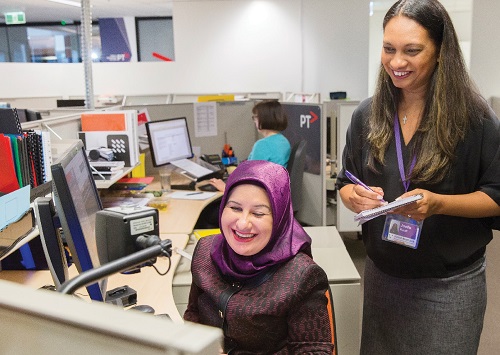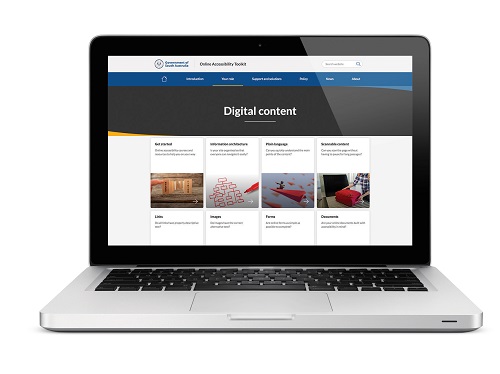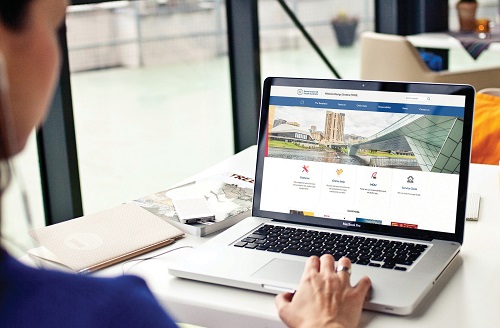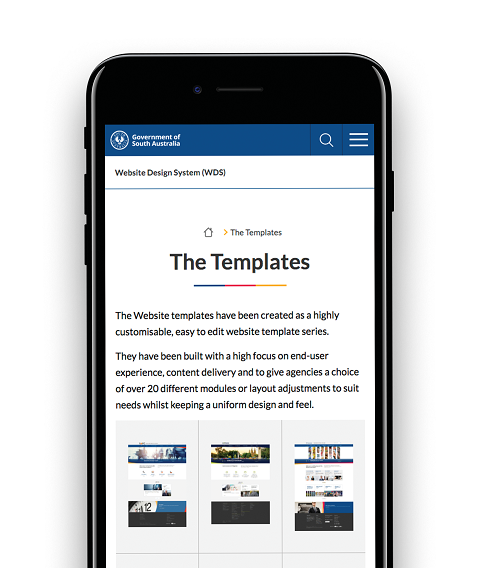Introduction
An estimated one in five Australians live with disability. With more and more essential services being accessed online, the importance of digital accessibility grows each day.
The question remains though, what is the best way to ensure organisations, both big and small, achieve this?
- Should we mandate that websites and digital resources meet accessibility standards?
- Or should more education, support and tools be provided?
The answer may come from South Australia.
Supported by new legislation, the state government (in partnership with Vision Australia, Royal Society for the Blind (SA) and a wide range of other organisations and bodies) has developed a range of resources.
The aim is to help create an environment where inclusion and accessibility are a key focus and achievable.
“There’s been an ongoing battle for about 15-20 years, but this is the first time this has been endorsed by a top- down approach. Over many years, we’ve discussed this with government, but in the last two years, we’ve actually participated in the development of the policy, the use of the words, the language and also the direction of what they take and how things are explained," Tony Starkey, Government Relations & Accessibility, Royal Society for the Blind of SA Inc (and as someone with a lived experience of visual disability), said.
"We are moving forward and taking a good leap. Hopefully, from now on, this will be the lead in the way government approaches policy design. And also, it could lead the government in the future in other areas such as urban planning, transport, aviation, whatever the topic is there’s an issue where we need to be involved is in trying to make it simple, accessible and also easier to use.”
Background
In 2018, the Disability Inclusion Act (the Act) became the first piece of legislation enacted by South Australia’s new state government. The Act:
- highlights the importance of equal access and inclusion for people living with disability
- requires the government to develop a new State Disability Inclusion Plan.
State and local government agencies are also required to put in place and report on their Disability Access and Inclusion Plans. This is to be done in full consultation with people with disability.

Online Accessibility Policy
The Department of the Premier and Cabinet saw the need for positive action.
Vision Australia’s Digital Access team were asked to review the South Australian Government’s old web accessibility policy.
The review found the policy needed to be updated to reflect the intention of the new Act. A new policy was needed to define modern requirements for their online presence. This would provide a pathway for other agencies to follow.
The review also showed that people who experienced disability should be part of planning the new policy.
Policy consultation reach
- Developed in partnership with us (Vision Australia), Royal Society for the Blind (SA) and people with lived experience of disability:
- 50 Members from the Local Government Access and Inclusion Network
- 450 Members from the South Australian Disability Engagement Group
- 600 Members from the South Australian disability sector
- 57,339 YourSAy subscribers (the SA Government’s community engagement platform)
- 1,000 State and local government staff surveyed
- 900 Members from the Australian Government communities of practice
- 11,756 Facebook users
- 150 Unique items of feedback incorporated in to the final policy
Developing the new policy
A government working group developed a draft policy. This aligned to the new Act, other accessibility guidelines and government standards, including Web Content Accessibility Guidelines (WCAG) 2.0 and 2.1, Australian standards to assist agencies with procurement of accessible ICT solutions, the Australian Commonwealth Government Digital Service Standards and other key Australian Government methodology and standards.
- The Digital Access team supported the government to move the draft policy through to public consultation.
- Royal Society for the Blind (SA) represented the needs of people living with disability in South Australia.
- The Department of Human Services ensured the work aligned with the intent of the new Act
Other bodies asked for input included:
- Australian Government’s Digital Transformation Agency
- local and state government staff from across South Australia
- other state and federal government agencies
- advocacy bodies and industry groups (including Equal Opportunity Commission, New South Wales Office for Digital Government, Blind Citizens Australia (SA), intopia, Carers SA, the Information Access Group and many others)
- members of the public through YourSAy (reaching a total of 57,339 registered YourSAy subscribers).
- South Australians with disability and the state’s disability sector also gave feedback. They included:
- South Australian Disability Register. This included more than 600 members from the disability sector.
- South Australian Disability Engagement Group. This group has over 450 members, including people with lived experience of disability, family members and their support networks.
- Local Government Access and Inclusion Network.
- Visitors to the Purple Orange and Developmental Educators Australia websites.

Next steps
Every item from the consultation process was reviewed. The final version went to the South Australian Government ICT and Digital Board for approval.
The South Australian Government’s Online Accessibility Policy was released on 16 May 2019, Global Accessibility Awareness Day (GAAD), and is mandatory for all agencies.
It provides a standard for digital channels across all levels of government in South Australia.
The policy is also supported with an ‘Easy Read’ guide (available at https://accessibility.sa.gov.au/policy/easy-read-online-accessibility-policy). Easy Read is widely used for audiences with disability. It also has broader benefits because it gives essential information on a topic without a lot of background information.
This can be especially helpful for:
- people who are not fluent in English
- people who need to get information quickly in times of crisis
- people who are time poor and don’t have time to wade through complex information.
Digital Access’ work also stressed a need for the right tools to support people in digital accessibility.
As a result, two resources were developed:
- the South Australian Government Online Accessibility Toolkit (accessibility.sa.gov.au)
- the South Australian Government Website Design
Online Accessibility Toolkit (accessibility.sa.gov.au)
Also launched on GAAD 2019, the South Australian Government’s Online Accessibility Toolkit (available at accessibility.gov.au) is a free online resource.
Using the toolkit means that digital platforms are built so Australians with disability can access them.
The toolkit provides expert and simple advice on how to create accessible digital platforms and content. The instructions are easy to read and navigate and work on different devices.
Early models of the toolkit were based on the US Government’s 18F Accessibility for Teams resource. This changed in response to:
- local user needs identified through feedback and user testing
- the need to align with Australian Government standards
- peer review by Vision Australia’s Digital Access Team.
Providing examples of limits facing people with a disability were:
- members from the South Australian disability sector
- the South Australian Disability Engagement Group
- the Local Government Access and Inclusion Network.
Further consultation was undertaken with members of the Australian cross-government service design communities of practice. They have nearly 900 members from local, state and federal government.
Key partners in this process included:
- Royal Society for Blind (SA)
- Blind Citizens Australia (SA)
- the GOV.UK team (UK Government)
- the Australian Government’s Digital Transformation Agency
- the 18F accessibility team (US Government)
- the Government of British Columbia (Canadian Government).

Caption: accessibility.sa.gov.au is a one-stop shop explaining the need for online accessibility and how to achieve it.
Dedication to the reader
The toolkit contains appropriate information for different role types.
It was also necessary to make it an approachable resource for all audiences.
Complicated language and jargon were avoided, and readability grade level assessed.
When developing the content, it was also important to consider accessibility and how long content took to read.
Explaining the benefits for all users
Each role-based page of the toolkit contains a drop-down menu titled “why it’s important”.
This explains the benefits of a particular accessibility measure. Each example comes from the point of view of both people who do and do not live with a disability. Everything is presented in a gender-neutral fashion.
An example: the toolkit explains the need to make sure Portable Document Formats (PDFs) are formatted correctly (available at https://accessibility.sa.gov.au/your-role/content/documents/portable-document-format-pdf):
- Sally is blind and only owns a mobile phone. Sally needs to access important information to be able to apply for support services. As there is no alternative version, Sally has to visit the library in town to use their desktop computers.
- Rosalie is a barrister and prefers to listen to information during the commute home. Rosalie is unable to listen to content in a PDF because it isn’t optimised for accessibility. Because the mobile phone reader is unable to understand the PDF, Rosalie now has to work in the evening.
- Ned is an electrician. Ned is unable to find important safety information as it’s only available in PDF format and is not showing up in a site search.
Vision Australia’s CEO Ron Hooton, said:
“It’s great to see the South Australian Government taking a leadership position. They have created tools helping all South Australian organisations develop digital accessibility.
We support more than 25,500 people across Australia who are blind or have low vision. We are confident this toolkit will lead to more accessible digital platforms. It will help people achieve the possibilities that they choose in life.”

Recognition
Australian Human Rights Awards 2019
October 2019, South Australian Government’s partnership with Vision Australian and Royal Society for the Blind (SA) named as one of five finalists in the Government Award category for accessibility.sa.gov.au. This recognised the work to combine policy with practical solutions to promote human rights and access to technology.
Australian Access Awards 2019
November 2019, toolkit named as a dual category finalist for:
- Accessibility Initiative of the Year
- Government Website.
May 2019, the toolkit achieved Plain English Campaign’s seal of excellence (an Internet Crystal Mark).
Department for Premier and Cabinet Employee Recognition Awards:
- 2018 Winner for ‘Contribution to the South Australian Community’: Inclusive Online Services
- 2018 High Achievement in ‘Performance Excellence’: Government Online Inclusion.
2019 South Australian iAwards finalist.
Website Design System
Website Design System is available to all South Australian Government agencies. This is through the Office for Digital Government, Department of the Premier and Cabinet.
Website Design System evolved from a previous South Australian Government offering, Website-as-a-Service (WaaS). WaaS was developed together with Vision Australia Digital Access, Squiz Australia and Royal Society for the Blind (SA).

Previous WaaS templates achieved Vision Australia’s Statement of Accessibility to WCAG 2.0 Level AA.
Yet, each website existed as a separate entity. This meant each website also had to be updated separately. Accessibility fixes often caused other issues due to agency changes.
With increased accessibility as the reason for the development of the Website Design System, The Office for Digital Government and Vision Australia believe the development of the system is a unique approach.
How it works
The new Website Design System:
- provides agencies with templates of simple and modern websites
- meets standards for mobile responsiveness
- meets compliance with South Australian Government security standards
- strives to meet, maintain and exceed compliance to WCAG 2.1 AA accessibility standards.
Customising the modular features allows agencies to maintain a unique online presence.
The module features can allow agencies to change them and stay unique.
Website Design System now provides agencies with a base website made up from over 30 WCAG 2.1 AA compliant modules. The modules include:
- the base template
- theme
- colour
- various content blocks (including Easy Read layouts)
- image layouts
- carousel types
- promotional banners
- progress bars (workflow)
- search options
- social media integrations
- video embeds
- events and news listings.
All these can allow changes, added or removed to suit each agency’s needs.
Each module is managed centrally. Upgrades and accessibility updates are developed, tested and deployed once at the top level. They then cascade to all sites.
The Office for Digital Government and Vision Australia believe the new Website Design System is valuable for digital inclusion as it now means inclusion is part of the planning stages for digital resources. It is no longer a costly afterthought.

Caption: Website Design System simplifies
accessibility for South Australian government
websites by providing customisable templates
that meet stringent accessibility standards.
Community reach
The Online Accessibility Policy and Toolkit has already had a positive affect and response within community.
The Whyalla Special Education Centre teaches students from foundation to year 12, including students with disability and complex learning needs. The centre was among the first to launch their website using the policy and toolkit as a guide (available at whyallasp.sa.edu.au).
Vision Australia’s Digital Access team also worked with Edu Net Solutions (the South Australian company behind the centre’s new website). This ensured their website template met Vision Australia’s Statement of Accessibility to WCAG 2.0 Level AA.
As a result, Edu Net Solutions were able to give staff, students, parents and carers an accessible online resource.
Everyone involved is happy that a body working with the disability community was one of the first to use the new resource.
Other initiatives
There is now a Digital Inclusion and Accessibility Meetup in Adelaide. This was recently started by the South Australian Government.
Neil King, National Manager for Digital Access at Vision Australia, spoke at the first event. Neil shared the importance of organisations including accessibility from the start of a project.

The Office for Digital Government team will help organise up to four meetups per year. This gives attendees an opportunity to connect and discuss online accessibility in an open forum.
The meetup is open to all, and anyone interested in joining can register by emailing [email protected].
The Office for Digital Government also provides other government agencies with accessibility services. These include:
- Key error reporting (basic check)
- Web Content Accessibility Guidelines (WCAG) lite assessments (more in-depth check)
- Coordination of external WCAG 2.0 or WCAG 2.1 auditing (completed to a certified standard)
- Usability testing services including coordination of assistive technology testing through external services
- Support to achieve and maintain standards in line with the Online Accessibility Policy.
For more information email [email protected].
Digital Access at Vision Australia
If you and your team need accessibility and inclusion advice – whether it’s about strategy, document design, a website upgrade, or you’re thinking of developing a whole new product or service – the Digital Access team is here to help.
For more information email [email protected].
Published by:
Vision Australia thanks Brio Group and TaggedPDF for their generous contribution in producing this case study.
Find out more about their expert services at www.briogroup.com.au and taggedpdf.com.au.
An accessible PDF of this case study has been produced by TaggedPDF and is available to download: Push and pull: Why South Australia leads the way in online accessibility (PDF, 2.8MB).










